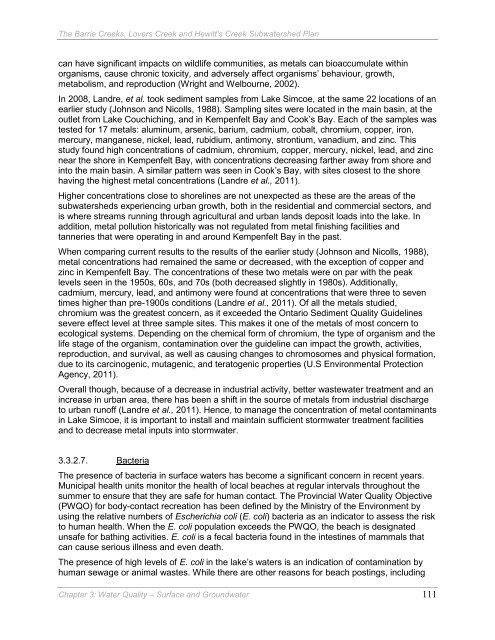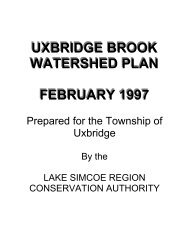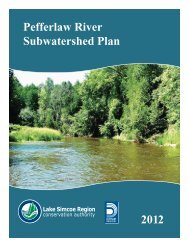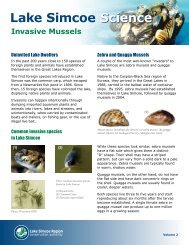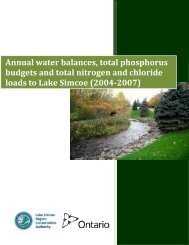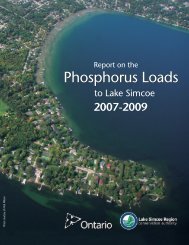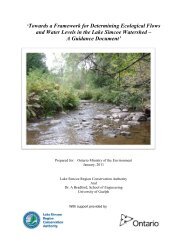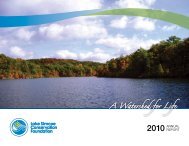Barrie Creeks, Lovers Creek, and Hewitt's Creek Subwatershed Plan
Barrie Creeks, Lovers Creek, and Hewitt's Creek Subwatershed Plan
Barrie Creeks, Lovers Creek, and Hewitt's Creek Subwatershed Plan
Create successful ePaper yourself
Turn your PDF publications into a flip-book with our unique Google optimized e-Paper software.
The <strong>Barrie</strong> <strong><strong>Creek</strong>s</strong>, <strong>Lovers</strong> <strong>Creek</strong> <strong>and</strong> Hewitt’s <strong>Creek</strong> <strong>Subwatershed</strong> <strong>Plan</strong><br />
can have significant impacts on wildlife communities, as metals can bioaccumulate within<br />
organisms, cause chronic toxicity, <strong>and</strong> adversely affect organisms’ behaviour, growth,<br />
metabolism, <strong>and</strong> reproduction (Wright <strong>and</strong> Welbourne, 2002).<br />
In 2008, L<strong>and</strong>re, et al. took sediment samples from Lake Simcoe, at the same 22 locations of an<br />
earlier study (Johnson <strong>and</strong> Nicolls, 1988). Sampling sites were located in the main basin, at the<br />
outlet from Lake Couchiching, <strong>and</strong> in Kempenfelt Bay <strong>and</strong> Cook’s Bay. Each of the samples was<br />
tested for 17 metals: aluminum, arsenic, barium, cadmium, cobalt, chromium, copper, iron,<br />
mercury, manganese, nickel, lead, rubidium, antimony, strontium, vanadium, <strong>and</strong> zinc. This<br />
study found high concentrations of cadmium, chromium, copper, mercury, nickel, lead, <strong>and</strong> zinc<br />
near the shore in Kempenfelt Bay, with concentrations decreasing farther away from shore <strong>and</strong><br />
into the main basin. A similar pattern was seen in Cook’s Bay, with sites closest to the shore<br />
having the highest metal concentrations (L<strong>and</strong>re et al., 2011).<br />
Higher concentrations close to shorelines are not unexpected as these are the areas of the<br />
subwatersheds experiencing urban growth, both in the residential <strong>and</strong> commercial sectors, <strong>and</strong><br />
is where streams running through agricultural <strong>and</strong> urban l<strong>and</strong>s deposit loads into the lake. In<br />
addition, metal pollution historically was not regulated from metal finishing facilities <strong>and</strong><br />
tanneries that were operating in <strong>and</strong> around Kempenfelt Bay in the past.<br />
When comparing current results to the results of the earlier study (Johnson <strong>and</strong> Nicolls, 1988),<br />
metal concentrations had remained the same or decreased, with the exception of copper <strong>and</strong><br />
zinc in Kempenfelt Bay. The concentrations of these two metals were on par with the peak<br />
levels seen in the 1950s, 60s, <strong>and</strong> 70s (both decreased slightly in 1980s). Additionally,<br />
cadmium, mercury, lead, <strong>and</strong> antimony were found at concentrations that were three to seven<br />
times higher than pre-1900s conditions (L<strong>and</strong>re et al., 2011). Of all the metals studied,<br />
chromium was the greatest concern, as it exceeded the Ontario Sediment Quality Guidelines<br />
severe effect level at three sample sites. This makes it one of the metals of most concern to<br />
ecological systems. Depending on the chemical form of chromium, the type of organism <strong>and</strong> the<br />
life stage of the organism, contamination over the guideline can impact the growth, activities,<br />
reproduction, <strong>and</strong> survival, as well as causing changes to chromosomes <strong>and</strong> physical formation,<br />
due to its carcinogenic, mutagenic, <strong>and</strong> teratogenic properties (U.S Environmental Protection<br />
Agency, 2011).<br />
Overall though, because of a decrease in industrial activity, better wastewater treatment <strong>and</strong> an<br />
increase in urban area, there has been a shift in the source of metals from industrial discharge<br />
to urban runoff (L<strong>and</strong>re et al., 2011). Hence, to manage the concentration of metal contaminants<br />
in Lake Simcoe, it is important to install <strong>and</strong> maintain sufficient stormwater treatment facilities<br />
<strong>and</strong> to decrease metal inputs into stormwater.<br />
3.3.2.7. Bacteria<br />
The presence of bacteria in surface waters has become a significant concern in recent years.<br />
Municipal health units monitor the health of local beaches at regular intervals throughout the<br />
summer to ensure that they are safe for human contact. The Provincial Water Quality Objective<br />
(PWQO) for body-contact recreation has been defined by the Ministry of the Environment by<br />
using the relative numbers of Escherichia coli (E. coli) bacteria as an indicator to assess the risk<br />
to human health. When the E. coli population exceeds the PWQO, the beach is designated<br />
unsafe for bathing activities. E. coli is a fecal bacteria found in the intestines of mammals that<br />
can cause serious illness <strong>and</strong> even death.<br />
The presence of high levels of E. coli in the lake’s waters is an indication of contamination by<br />
human sewage or animal wastes. While there are other reasons for beach postings, including<br />
Chapter 3: Water Quality – Surface <strong>and</strong> Groundwater 111


